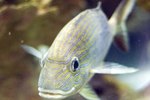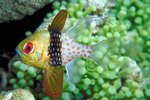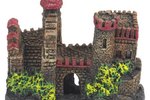Things You'll Need
55-gallon drum
Gravel and larger rocks
Natural cover
Aquarium pump
Hose
Fish
Fish food
Keeping fish has become a popular pastime. Although aquariums large and small can be purchased to contain nearly every species of fish imaginable, some people choose to raise their fish in larger containers such as 55-gallon drums. These drums allow you to house larger species of fish and can easily be placed outdoors to beautify your landscape. Growing fish in 55-gallon drums is not difficult and requires just a few readily available items.
Wash out your drum with a generous amount of clean water. Any dust or grime in the drum can make your fish ill, so scrub the interior well and turn the drum upside down, allowing it to dry completely.
Line the bottom of your drum with an inch or two of gravel, placing a few larger rocks on top of the gravel. The natural habitat of most species of fish includes a gravel floor with bigger rocks to hide under and around, so adding these to your drum will mimic their normal environment.
Add some natural cover to your drum. Elements such as plants, deadwood and floating logs can be found in most bodies of water, and providing your fish with such cover will give them a few places to hide and feel safe. You can harvest these items from your property or purchase them from an aquarium supply store.
Set your pump down into your drum, resting it on the gravel bottom. The pump will agitate and add oxygen to the water, which is necessary to prevent algae growth and sustain your fish. A pump designed for a 40-gallon aquarium will be adequate for oxygenating your drum.
Fill your drum with clean, fresh water. Lay the hose down on the bottom of the drum. To avoid disturbing your plants, begin running the water at a low rate. Once the drum is full, let it sit for at least 24 hours before adding your fish. That will allow the chlorine in the water -- which is harmful to most fish species -- to evaporate.
Place your fish in the water slowly, pouring them, along with the water from the container in which you transported them, into the drum. Your fish will appear agitated for a few minutes, but they will eventually calm down and explore their new environment. To allow them to become accustomed to the drum, let them relax for at least a day before feeding.
Feed your fish a commercially available fish food once a day. Different species of fish require different types of food, so purchase a food specifically formulated for your fish. You can supplement their diet with small insects such as crickets and worms to replicate what they would eat in the wild. To prevent overfeeding, only feed as much as your fish will consume in a few minutes.
Tips
Examine your barrel weekly for algae and cloudy water. If you find these conditions, drain one-third of the water from the barrel and refill the barrel with clean water. This water change will help clean up any contaminants.
Warnings
Never mix fish species unless you are sure they are compatible. Many species of fish are highly aggressive and will attack and even kill more docile species. If you are unsure, speak with an experienced fish owner to determine the compatibility of your fish.
References
Photo Credits
-
Jupiterimages/Photos.com/Getty Images
Writer Bio
Louise Lawson has been a published author and editor for more than 10 years. Lawson specializes in pet and food-related articles, utilizing her 15 years as a sous chef and as a dog breeder, handler and trainer to produce pieces for online and print publications.





